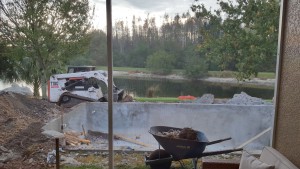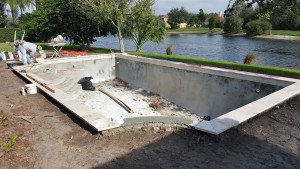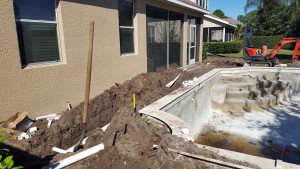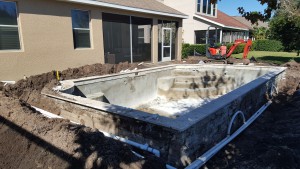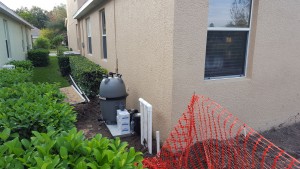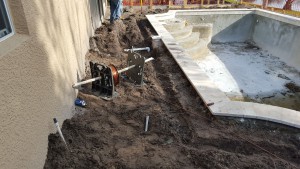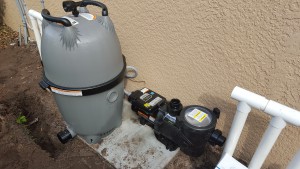What to expect when building an in ground pool – Part 4
Part 4 – Rough Grade, Tile, Plumbing, Electrical
Key Points:
- At this stage, the construction area and the access area are in pretty rough shape
- Take action necessary to keep children and pets out of the construction area
- Take pictures of plumbing and electrical elements that will be buried, just in case there is an issue later
- The electrician may be able to install additional outlets, etc… while they are on site
Clean up and Rough Grade
At this stage, the construction area and the access area are in pretty rough shape. There will be broken wooden forms (with the possibility of stray nails exposed), large sheets of plastic, misc. trash, chunks of excess concrete, etc… all around the construction area. The access path(s) will have been traveled hundreds of times by people and equipment. In wet weather conditions, you may have large ruts and a muddy mess. Make what arrangements are necessary to keep children and pets from entering these areas as they may be unsafe.
Your builder will have a work crew come in once the concrete shell is fully set. The crew will be utilizing a dump truck and a skid steer loader on this day, so make sure there is parking and access that day. They will begin by removing the trash and miscellaneous debris from the construction area and the access path. The crew will do a very rough grade around the pool shell, which means the ground will be leveled off enough for the next steps in the building process to occur.
Tile Installation
In many cases, there will be tile installed in or around your pool. A tile contactor will have their team install the tile in the interior and on additional pool features, such as steps or waterfalls. Depending on the decking you have chosen, they may also install tile or pavers around the edge of the pool shell.
Plumbing
The concept of pool plumbing is relatively simple. The system is a circle. A pump sucks the water out of the pool, runs it through a filter, and pumps it back into the pool. As you add options to your pool, the system is still a circle; however, the plumbing can become quite complex. I would suggest that you take pictures of the underground plumbing before they cover it up. In the event that there is ever an issue, these pictures could be helpful.
On installation day, plumbers will dig trenches from the pumps intended location to the pool shell and around the edges. These trenches will hold the plumbing for your pool. Your pool will have a number of inputs around the edge. This is where the water enters the pool. Any additional water features, such as bowls or waterfalls which pump water into the pool, will also need to be plumbed as inputs. Most pools will have two returns to bring the water out of the pool and back to the pump. One return is located on the top edge and pulls surface water while the other is located at the deepest part on the bottom of the pool. When the pool shell was formed, there were pieces of the plumbing put in place to reserve space for the inputs and returns inside the pool shell.
Unless your pool is very large or complex, this process will most likely be done in one day.
Electric
The next group of contractors will most likely be electricians and their assistants. This process can vary greatly, based on the power required by all the electrical elements in your pool and the sources your home already has in place. Adding multispeed or multiple pumps to support water features, enhanced lighting elements, or an electric heat pump can require a significant amounts of electricity.
The electricians install the wiring and equipment necessary to support the needs of your pool and will generally locate all the elements in the same area outside. They will add control boxes and timers for the lighting and water features installed in your pool and wire up the pump(s). You will also notice that they install additional wiring around your pool area to create a grounded circuit. In the unfortunate event that lightning strikes, this extra ground may help to limit damage to equipment.
If you were considering adding any electric outlets or other elements in the pool/patio area, the electrician may be able to perform the work while on site that day.
As with the plumbing, I would suggest that you take pictures of wiring that will be underground before it is covered. If there is ever an issue, this may be helpful.
Unless your pool is very large or complex, this process will most likely be done in one day.
Coming Soon. Part 5


